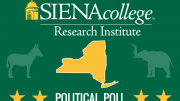NY Council on Problem Gambling/Siena College: Special Capital Region Poll
50% in Capital Region Plan to Visit New Casino; 31% to Gamble, 42% for Spa, Dining, 20% to Shop
Mixed on Casino’s Impacts; See Jobs & Revenues But Also Social Problems; Majority Says NY Gambling Amendment Right Decision
8 of 10 Gamble, at Least a Little; Scratch-offs, Track, Slots, Sports, Most Popular
2/3rds Think Casinos will Increase Problem Gambling; More a Disease than a Choice; Look to Treatment Programs, Gamblers Anonymous to Help
Loudonville, NY. Half of Capital Region residents plan to visit the new Rivers Casino in Schenectady according to a new poll of residents of six area counties sponsored by the New York Council on Problem Gambling (NYCPG) and conducted by the Siena College Research Institute. While large majorities agree that new casinos will create thousands of jobs for New Yorkers and that new non-Native American casinos will bring in significant revenues for state and local governments, over half of area residents say new casinos will increase societal problems such as crime and compulsive gambling.
“Nearly one-third of Capital Region residents plan to visit the new casino in Schenectady to gamble,” said Siena College Research Institute Director Don Levy. “Even larger numbers, over forty percent plan to go there for some form of entertainment including the spa or dining while one in five intend to go there to shop. Nearly half of area residents say that they approve of the opening of the Rivers Casino while only 22 percent disapprove.”
“Most respondents favor the new casinos because they expect them to create many new jobs, albeit at the risk of increased problem gambling. Although many casino patrons gamble without negative consequences, others do develop gambling problems. This underscores the need for increased education and treatment programs,” according to Edelgard Wulfert, NYCPG Board Member and Professor of Psychology at SUNY Albany.
While 98 percent of residents believe that some people have problems controlling their gambling a majority, 52 percent, say that problem gambling is not a very, or not at all a significant problem while 37 percent say it is either a somewhat or very significant problem. Nearly one-third say that they know someone that they think might have a gambling problem and by 66-32 percent they agree that increasing the number of casinos will increase the number of people with gambling problems. Still, overall, a majority of 53-35 percent think the State made the right rather than wrong decision legalizing non-Native American casino-style gambling in New York.
Seventy-eight percent of residents agree that legalizing casinos in New York will create thousands of jobs and 67 percent say that casinos will bring in significant new revenues for state and local governments. But 55 percent agree that new casinos will only increase societal problems such as crime and compulsive gambling and 56 percent say that we already have enough outlets for gambling in New York.
Asked if they had gambled or bet on any of ten different activities over the last year, 21 percent of area residents had not but 79 percent had. In rank order with the percent that had at least bet or gambled once or twice during the last year we found Capital Region residents participating in: buying scratch-off or any kind of lottery ticket (67 percent), betting at the racetrack (33 percent), playing slots at a casino (26 percent), betting on sports or fantasy sports (15 percent), playing table games at a casino (14 percent), playing cards or dice for money (14 percent), playing games of skill for money (12 percent), playing bingo for money (10 percent), placing bets at an off-track facility (9 percent), participating in online gambling (2 percent).
A majority of residents, 56 percent, say that problem gambling is a disease that people need help overcoming while 41 percent are more likely to agree that problem gambling is a personal choice and that it is the individual’s own responsibility to overcome it. Seventy-nine percent say that if someone has a problem with their gambling behavior they should go to Gamblers Anonymous and 72 percent recommend a gambling treatment program. Only 11 percent are aware of any problem gambling treatment services in their area.
“The survey results support our view that both raising the awareness of problem gambling and providing services for problem gamblers and their families is crucial as new casinos open,” according to Jim Maney, Executive Director of the New York Council on Problem Gambling.
Individuals seeking help for a gambling problem can call the toll-free OASAS HOPEline at 1-877-846-7369.
******
This NYCPG/Siena College Poll was conducted January 8-11, 2017 by landline and cell telephone calls with 902 residents of Albany, Fulton, Montgomery, Rensselaer, Saratoga and Schenectady Counties. Respondent sampling was initiated by asking for the youngest male in the household. It has an overall margin of error of +/- 4.0 percentage points including the design effects resulting from weighting. Sampling was conducted via a stratified dual frame probability sample of landline and cell phone telephone numbers (both from Survey Sampling International) from within New York State weighted to reflect known population patterns. Data was statistically adjusted by age, race/ethnicity, region and gender to ensure representativeness. The Siena College Research Institute, directed by Donald Levy, Ph.D., conducts political, economic, social and cultural research primarily in New York State. SRI, an independent, non-partisan research institute, subscribes to the American Association of Public Opinion Research Code of Professional Ethics and Practices. For more information, call Don Levy at (518) 783-2901 or dlevy@siena.edu. For survey cross-tabs and frequencies: www.Siena.edu/SCRI





